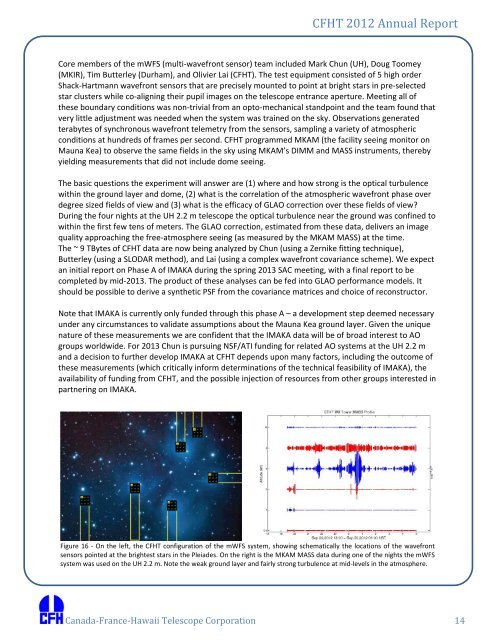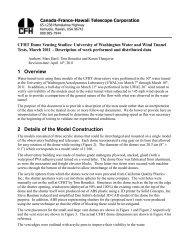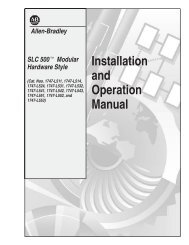2012 CFHT Annual Report - Canada France Hawaii Telescope ...
2012 CFHT Annual Report - Canada France Hawaii Telescope ...
2012 CFHT Annual Report - Canada France Hawaii Telescope ...
You also want an ePaper? Increase the reach of your titles
YUMPU automatically turns print PDFs into web optimized ePapers that Google loves.
<strong>CFHT</strong> <strong>2012</strong> <strong>Annual</strong> <strong>Report</strong><br />
Core members of the mWFS (multi‐wavefront sensor) team included Mark Chun (UH), Doug Toomey<br />
(MKIR), Tim Butterley (Durham), and Olivier Lai (<strong>CFHT</strong>). The test equipment consisted of 5 high order<br />
Shack‐Hartmann wavefront sensors that are precisely mounted to point at bright stars in pre‐selected<br />
star clusters while co‐aligning their pupil images on the telescope entrance aperture. Meeting all of<br />
these boundary conditions was non‐trivial from an opto‐mechanical standpoint and the team found that<br />
very little adjustment was needed when the system was trained on the sky. Observations generated<br />
terabytes of synchronous wavefront telemetry from the sensors, sampling a variety of atmospheric<br />
conditions at hundreds of frames per second. <strong>CFHT</strong> programmed MKAM (the facility seeing monitor on<br />
Mauna Kea) to observe the same fields in the sky using MKAM’s DIMM and MASS instruments, thereby<br />
yielding measurements that did not include dome seeing.<br />
The basic questions the experiment will answer are (1) where and how strong is the optical turbulence<br />
within the ground layer and dome, (2) what is the correlation of the atmospheric wavefront phase over<br />
degree sized fields of view and (3) what is the efficacy of GLAO correction over these fields of view?<br />
During the four nights at the UH 2.2 m telescope the optical turbulence near the ground was confined to<br />
within the first few tens of meters. The GLAO correction, estimated from these data, delivers an image<br />
quality approaching the free‐atmosphere seeing (as measured by the MKAM MASS) at the time.<br />
The ~ 9 TBytes of <strong>CFHT</strong> data are now being analyzed by Chun (using a Zernike fitting technique),<br />
Butterley (using a SLODAR method), and Lai (using a complex wavefront covariance scheme). We expect<br />
an initial report on Phase A of IMAKA during the spring 2013 SAC meeting, with a final report to be<br />
completed by mid‐2013. The product of these analyses can be fed into GLAO performance models. It<br />
should be possible to derive a synthetic PSF from the covariance matrices and choice of reconstructor.<br />
Note that IMAKA is currently only funded through this phase A – a development step deemed necessary<br />
under any circumstances to validate assumptions about the Mauna Kea ground layer. Given the unique<br />
nature of these measurements we are confident that the IMAKA data will be of broad interest to AO<br />
groups worldwide. For 2013 Chun is pursuing NSF/ATI funding for related AO systems at the UH 2.2 m<br />
and a decision to further develop IMAKA at <strong>CFHT</strong> depends upon many factors, including the outcome of<br />
these measurements (which critically inform determinations of the technical feasibility of IMAKA), the<br />
availability of funding from <strong>CFHT</strong>, and the possible injection of resources from other groups interested in<br />
partnering on IMAKA.<br />
Figure 16 ‐ On the left, the <strong>CFHT</strong> configuration of the mWFS system, showing schematically the locations of the wavefront<br />
sensors pointed at the brightest stars in the Pleiades. On the right is the MKAM MASS data during one of the nights the mWFS<br />
system was used on the UH 2.2 m. Note the weak ground layer and fairly strong turbulence at mid‐levels in the atmosphere.<br />
<strong>Canada</strong>‐<strong>France</strong>‐<strong>Hawaii</strong> <strong>Telescope</strong> Corporation 14




![Documentation [PDF] - Canada France Hawaii Telescope ...](https://img.yumpu.com/26965302/1/190x245/documentation-pdf-canada-france-hawaii-telescope-.jpg?quality=85)







